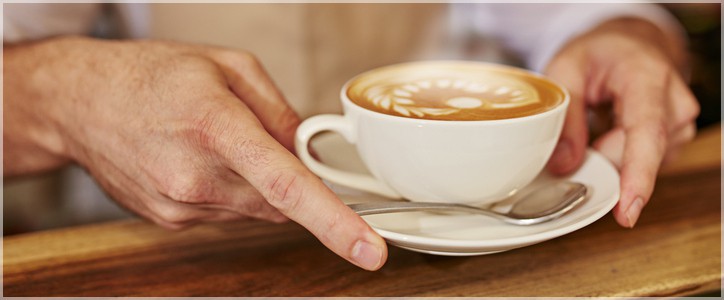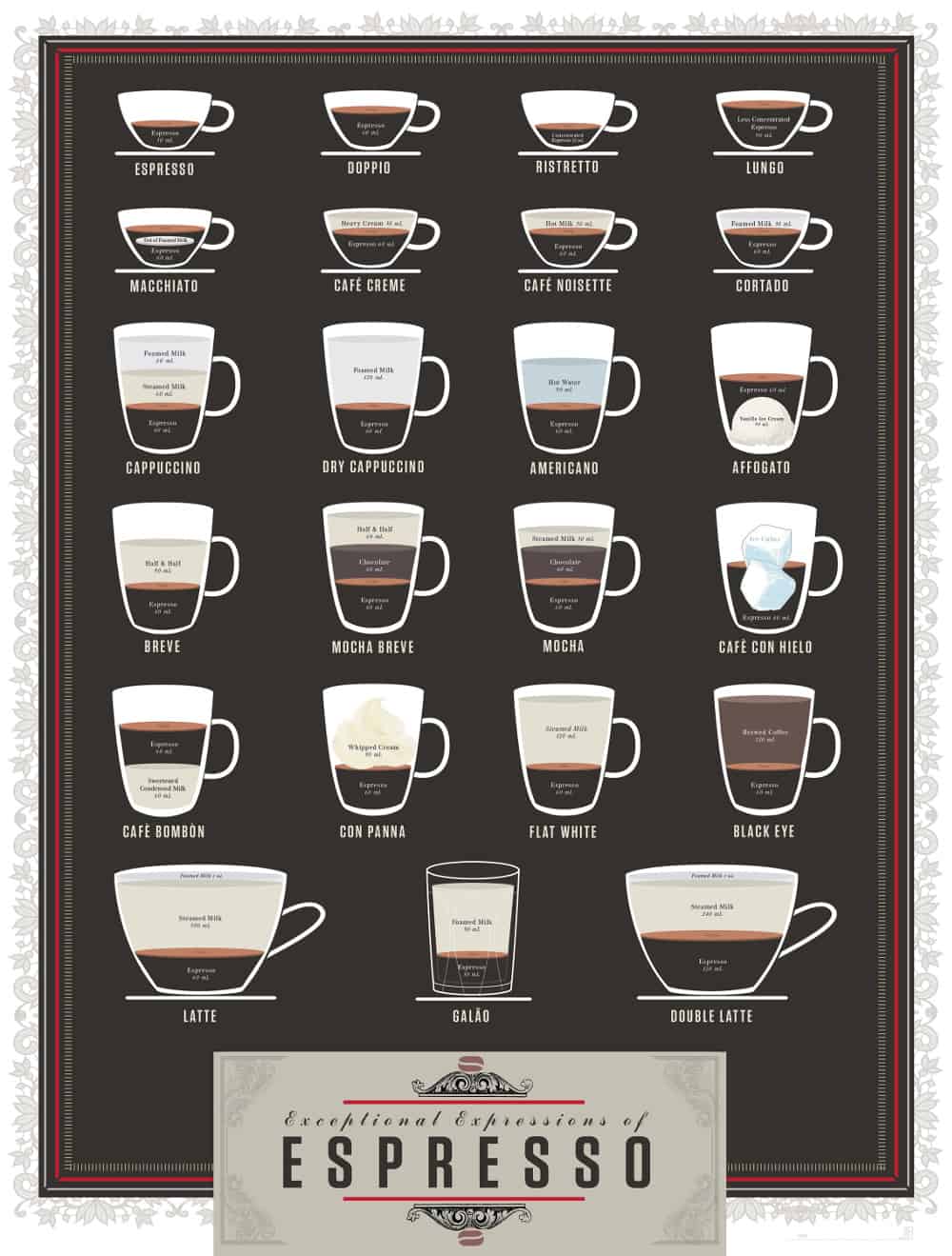
Lattes are light and airy espresso-based drinks, topped with frothed milk. With a mix of milk+foam to espresso, they're relatively mild flavored compared to black coffee drinks and tend to taste smooth.
Jump to:
Latte vs Cappuccino
A latte is sometimes known as a Wet Cappuccino.
While most people will get a latte or cappuccino from a specialty coffee shop (and sometimes an automatic vending machine - ew), they can be made at home with the right equipment and some practice.
An Espresso Cappuccino is simply a Cappuccino, denoting that espresso has been used rather than strong-brewed coffee.
Lattes are generally 2 fluid ounces of espresso to 3 fluid ounces of steamed milk and a small foam topping.
Cappuccinos are a 1:1:1 ratio of espresso to milk to foam (eg. 2-oz to 2-oz to 2-oz).
As always, start with a freshly roasted, great espresso bean. This doesn't necessarily have to be a blend from a coffee roaster, if you feel a little adventurous you can try out various single-origin coffees in different roasts. Those who prefer the traditional dark-roasted coffee flavor (rather than single-origin nuances) will still want to get a dark roast.
Coffee
Your coffee selection will be entirely dependent on your own personal taste. Traditionally, an "Espresso" is used, which technically only refers to the coffee grind (ground for an espresso machine) but commonly just refers to a very dark roasted coffee. With the rise of third-wave coffee roasters, premium light and medium roasts are becoming more popular for use in espresso, and are completely valid. The flavor will vary from a traditional espresso cappuccino with more single-origin flavors shining through, and having a brighter taste thanks to the presence of more coffee acids.
Out Top 3 Best Espresso for Cappuccinos include:
- Colombian Supremo (for a smooth, mellow drink)
- Ethiopian Yirgacheffe (for a vibrant, citrus/berry flavor)
- Sumatra Mandheling (for spicy, earthy flavor)
We recommend going with a darker roast for more traditional coffee flavor, and a medium roast for a more third-wave/gourmet coffee experience.
Make sure and pre-warm the demitasse before you begin brewing the espresso shot(s) for your Cappuccino, or any other specialty espresso coffee drink, or when you are just brewing a straight espresso. This helps to avoid premature cooling of espresso when it comes into contact with the cup. You can also use a very strong-brewed coffee if you don't have access to an espresso machine or to use a stove-top espresso maker.
Milk
Learning to steam and froth milk is probably the step that most aspiring home baristas can practice and work on to get the most improvement out of making their Starbucks-style lattes at home. A high-fat milk is ideal for steaming, or a dairy-alternative that's been specifically formulated for lattes like Pacific Barista Oat Milk.
Make sure the frothed milk reaches a temperature of at least 145º Fahrenheit but avoid a higher temperature as this may burn the milk. You'll want to angle your frothing pitcher so that the steaming wand creates a circular motion with the milk, rotating around the pitcher to get an even steam. The tip should be just under the top of the milk, creating small microfoam bubbles rather than larger ones. It should sound a little like a sizzling grill. To ensure velvety, creamy milk, see the Espresso Coffee Guide section on Steaming and Frothing Milk.
Next allow the milk to rest for just a few moments. This will let the foam rise to the top while the milk remains on the bottom. This will be important for the proper layering of your Latte or Cappuccino.
Side note: You can use milk alternatives such as almond, soy and coconut milk in lieu of regular milk to make a latte. These are especially useful for people who are lactose intolerant or have a dairy sensitivity, but can be a fun experience for anyone. While the products off a grocery store shelf can be used, there are superior products (like those from Pacific Barista) that are specially formulated for steaming and frothing for specialty coffee drinks.
For a cafe-style drink, flavors can even be added to replicate what you get at your favorite coffee shop, including Caramel Macchiatos, Pumpkin Spice Lattes and Peppermint Lattes - all at a fraction of the cost of buying from a cafe.
Sugar + Flavors
Any kind of sugar can be used in a latte, including regular white sugar, demerara, honey, agave and maple syrup. For the most sweetness without flavor, white sugar is the best option.
The sweetness level here is entirely personal, ranging from non at all to candy-like levels. For health reasons, it's best to shoot for as little sweetness as possible while bringing out the flavor of the milk and coffee.
If you are using any flavored syrups for your Latte, make sure to add the flavoring directly to the espresso shot(s) and then stir it very well to ensure that it dissolves properly.
Whether you're using premade syrups from Monin or Torani, both are designed to take the heat of coffee and espresso based drinks without the flavoring components breaking down - but this might not be the case with cheaper flavoring products. On the higher end of the spectrum, organic coffee syrups can add the delicious taste of chocolate, hazelnut and caramel without artificial ingredients.
It should be noted that some flavors are specifically designed to be used with milk-products, in cappuccinos and lattes, to bring out the most flavours. The fats in the milk work to enhance certain flavors that can be easily overwhelmed by a strong espresso, with higher fat content dairy working best.
Looking to cut back on calories in your coffee? Sugar-Free Flavor Syrups are also available, using Sucralose (typically Splenda-brand) as a sweetener instead of sugar. Sucralose is designed to withstand the high heat of coffee drinks without degrading in flavor, and most syrup companies have a well balanced sweetness-to-flavor profile which avoids any artificial aftertaste.
Finally add the steamed and frothed milk to your specialty espresso drink. Then enjoy!
Cappuccinos can also be flavored, but are done less commonly, as they're seen as much of a purist coffee drink.
For step-by-step instructions see our comprehensive list of Espresso Drink Recipes as well as recipes for Espresso Cuisine.
Cascara Latte
Cascara is the dried fruit that surrounds the coffee bean, and has become popular as an alternative to coffee. When brewed it is technically closer to a tea than coffee, however it contains higher levels of caffeine and nutrients. Most brewing instructions are very similar to regular tea - 4-5 minutes with water fresh of a boil - but this would be too weak for a proper cascara latte. We recommend using a lower quantity of water (4 oz) and steeping it longer, up to 15 minutes.
Activated Charcoal Latte
You can add activated charcoal to a latte to make it an activated charcoal latte.
Tips
Buy Gourmet Coffee Beans
- ✔️ Fresh roasted to order
- ✔️ 100% high qualtiy Arabica coffee
- ✔️ Custom grind (or whole bean)
- ✔️ 1-way valve, laminate bag (for freshness)
- ✔️ Bulk discounts



Mark Stifler
which one is better?making a coffe latte using latte machine or handmade?
Lita Watson
Thank for sharing! Do you think that the latte machine can make the latte is as good quality as handmade?
EspressoCoffeeGuide
Unfortunately "latte machines" typically used a powdered milk product full of artificial ingredients (high fructose corn syrups, etc) that will never come close to a real latte. The best alternative to genuine frothing machine is to microwave milk and use a whisk to whip it.